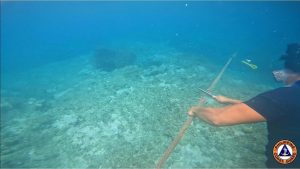The Philippine Coast Guard (PCG) said yesterday it had removed an underwater barrier installed by China’s coast guard to block access to a lagoon on a disputed shoal in the South China Sea.
The 300-meter barrier across the southeastern entrance to Scarborough Shoal was discovered by personnel from the PCG and Bureau of Fisheries and Aquatic Resources during a routine maritime patrol on Friday. The PCG subsequently publicly condemned the installation of the barrier, which it said had prevented fishermen from nearby Luzon from entering the shoal, “depriving them of their fishing and livelihood activities.”
The PCG said in a statement last night that it had successfully executed a “special operation” to remove the rope and net barrier following an order of President Ferdinand Marcos Jr. It argued that the barrier “posed a hazard to navigation, a clear violation of international law.”
“The decisive action of the Philippine coast guard to remove the barrier aligns with international law and the Philippines’ sovereignty over the shoal,” the PCG said. “The PCG remains committed to upholding international law, safeguarding the welfare of Filipino fisherfolk and protecting the rights of the Philippines in its territorial waters.”
The PCG also released photos and video, which showed a diver cutting a rope in shallow waters. The footage appeared to correspond to images released by the PCG on Sunday, showing a submerged barrier anchored by a line of circular white buoys.
Scarborough Shoal lies around 198 kilometers due west of Luzon, well within the Philippines internationally recognized exclusive economic zone (EEZ). But the triangular shoal fell under China’s control after a 10-week stand-off with the Philippines in 2012, and the China Coast Guard (CCG) has maintained a nearly permanent presence at the shoal in the 11 years since.
It is somewhat surprising that the Philippine personnel were able to remove the barrier without intervention from the CCG. The PCG statement did not detail if any Chinese vessels were present, and what their reaction was, if any.
In response to Friday’s incident, Chinese Foreign Ministry spokesperson Wang Wenbin said yesterday that the shoal and its adjacent waters are “China’s inherent territory,” where Beijing “has indisputable sovereignty,” according to The Associated Press.
A Philippine government fisheries vessel “trespassed into the waters” without China’s permission on Friday, Wang said, and “attempted to intrude into the lagoon” of the shoal. “China’s coast guard took the necessary measures to stop and warn off the ship in accordance with the law, which was professional and with restraint,” he said.
As I noted yesterday, the installation of the barrier is just the latest in a string of incidents in the South China Sea that have strained Philippine-China relations this year.
The incident also arguably demonstrates that the Philippine government’s new strategy of inviting media outlets to accompany is beginning to bear fruit. Unlike under the administration of President Rodrigo Duterte, when information about Chinese incursions into the Philippines’ EEZ was carefully controlled, the Marcos administration has taken pains to dramatize the David-versus-Goliath struggle that is taking place in Philippine-claimed portions of the South China Sea. As a result, each of the frequent stand-offs with the China Coast Guard is now being vividly captured and broadcast to the world.
The increased media coverage of Chinese assertiveness in contested waters serves to reinforce the legal victory that Manila won in 2016, when an arbitral tribunal in The Hague ruled that China’s expansive maritime claim over nearly the entire south China Sea had no validity under international law.
Whether this ultimately makes much difference to the country’s ability to defend its portions of the South China Sea over the long term, or whether it would induce outside powers to intervene militarily on its behalf, is hard to say. But for now, the Philippines is playing its weak hand with considerable skill.

































